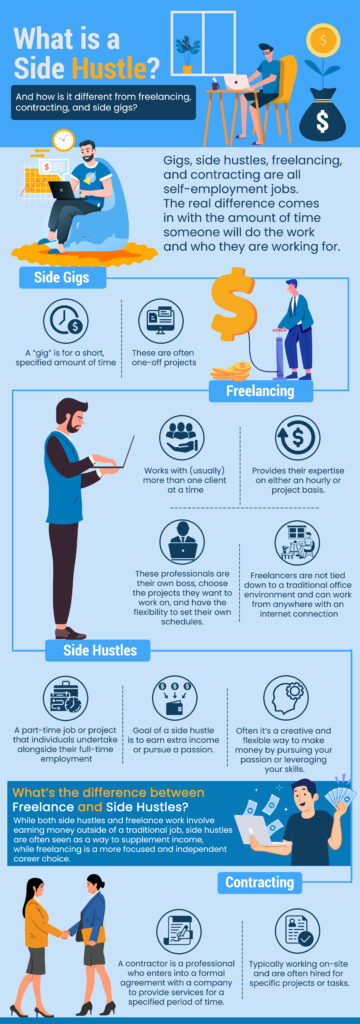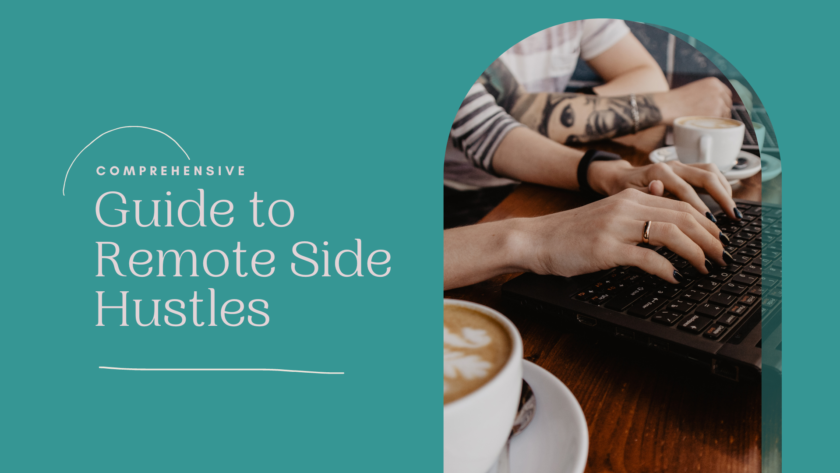Side Hustling: Unleashing the Power of Earning Extra Income
Estimated reading time: 29 minutes
Table of contents
- Side Hustling: Unleashing the Power of Earning Extra Income
- What is Side Hustling?
- Side Hustling vs. Full-Time Job
- Are Side Hustles the Same as Side Gigs/Freelancing/Contracting
- Who Needs a Side Hustle?
- How to Start a Side Hustle
- Challenges of Having a Side Hustle
- What are the best side hustles?
- Side Hustling Tips
- Where to Find Remote and Work from Home Side Hustles
- Conclusion
- What’s Next?
Side hustling is a term that’s been buzzing around for quite some time. It’s a way for folks to make extra cash outside their regular job hours. This isn’t about working a second job, but rather, creating your own opportunities. Whether it’s selling handmade crafts, offering freelance services, or renting out a property, a side hustle can provide a financial cushion or even become a full-time gig. You’ll hear gigs like driving for Uber or delivering food for DoorDash referred to as side hustles too.
But in this blog, we’re focused on remote and work-from-home side gigs (no Uber driving here!). We’ll dive deep into the exciting world of side hustling, exploring its meaning, benefits, and potential pitfalls to guide you on the path of finding a remote side hustle.
What is Side Hustling?
Defining Side Hustling
So you’ve probably heard the term “side hustling” being thrown around a lot lately, but what exactly does it mean? Well, to put it simply, a side hustle is a way to make extra money on the side outside of your regular job or career. It’s all about finding creative and innovative ways to generate additional income while still maintaining your primary source of income.
Benefits of Side Hustling
Now that we know what side hustling is, let’s explore some of the benefits it can bring into your life. Here are a few reasons why you might want to consider starting a side hustle:
- Financial Freedom: Side hustling offers you the opportunity to improve your financial situation by bringing in extra income. Whether you want to pay off debts, save for a vacation, or build an emergency fund, a side hustle can help you achieve your financial goals faster. (I did this to pay off debt a few years ago!)
- Skill Development: Starting a side hustle allows you to explore your passions and interests outside of your main job. It gives you the chance to learn new skills, develop your talents, and potentially even turn your side hustle into a full-time career if you choose to do so.
- Diversification: Relying solely on one source of income can be SO risky – especially in today’s economy. By having a side hustle, you create an additional revenue stream, reducing your reliance on a single source of income. This diversification can provide a sense of security and stability.
- Flexibility: Unlike a traditional 9-to-5 job, side hustles often offer more flexibility in terms of working hours and location. You have the freedom to choose when, where, and how much you want to work. This flexibility can be particularly beneficial for those with busy schedules or other commitments.
- Personal Growth: Side hustling can be a transformative experience that pushes you outside of your comfort zone. It challenges you to think creatively, problem-solve, and take risks. Whether it’s building a website, marketing your services, or managing your finances, you’ll gain valuable skills and grow as an individual.
- Building a Professional Network: Another significant advantage of having a side hustle is the opportunity to build a diverse and extensive professional network. As you engage with clients, customers, and colleagues in your side hustle, you have the chance to connect with individuals from different industries and backgrounds. These connections can be invaluable for future career opportunities, collaborations, and mentorship. Building a strong professional network can open doors and provide support and guidance throughout your career journey.
- Opportunity for Passion Projects: Have a hobby or passion that you’ve always dreamed of turning into a business? A side hustle can be the perfect platform to pursue your passion projects while still maintaining the security of your regular job.
The Power of a Side Hustle
For me, the power of side hustling has always been the ability to scale things up and down as needed. Meaning – if work is extra busy this month, I can scale back. If I have a trip or big expense, I can scale it up. Or if (God forbid) my full-time work situation goes wrong – layoffs, toxic environment, or I need to leave for some reason – I have something I can scale up to cover my previous income.
In conclusion, side hustling is all about embracing opportunities to make extra money outside of your primary job. It offers numerous benefits, including financial freedom, skill development, diversification, flexibility, personal growth, and the chance to pursue your passions. So why not explore the world of side hustles and unlock your full earning potential?
Side Hustling vs. Full-Time Job
In today’s fast-paced and ever-changing world, many people are turning to side hustles as a means of supplementing their income or pursuing their passions. With the rise of the gig economy, side hustling has become a popular choice for those seeking flexibility, additional income potential, and opportunities for skill development. In this section, we will explore the key differences between side hustling and a full-time job, focusing on flexibility, income potential, and skill development.
Flexibility
One of the main advantages of side hustling is the flexibility it offers. Unlike a traditional full-time job, side hustles allow individuals to choose when, where, and how much they work. This flexibility is particularly beneficial for those who have other commitments, such as caring for family members, pursuing education, or maintaining a primary job. Side hustles provide the freedom to work on your own terms, allowing you to set your own schedule and prioritize your responsibilities accordingly.
Income Potential
While full-time jobs often provide a steady and predictable income, side hustles have the potential to generate additional earnings. Depending on the nature of the side hustle and the effort put into it, individuals can significantly boost their income. In fact, some people have even managed to turn their side hustles into full-time businesses. The key to maximizing your income potential with a side hustle is to get good at your offering, be consistent, and impress the people you are serving.
Skill Development
Another advantage of side hustling is the opportunity for skill development. Unlike a full-time job that may provide limited growth and learning opportunities, side hustles allow individuals to explore new areas, learn new skills, and expand their knowledge. Whether it’s creating handmade crafts or offering freelance services, side hustles enable you to develop entrepreneurial skills, improve your time management abilities, and refine your problem-solving capabilities. Additionally, the experience gained from side hustles can be valuable when seeking new job opportunities or pursuing further career advancement.
Are Side Hustles the Same as Side Gigs/Freelancing/Contracting
This is a great question! Sometimes people use these interchangeably, which just adds to the confusion. Gigs, side hustles, freelancing, and contracting are all self-employment jobs (1099 instead of W2 when it comes to taxes). The real difference comes in with the amount of time someone will do the work and who they are working for.

Side Gig
Gigs are popular in today’s economy due to the rise of the gig economy and the increasing demand for flexible work options. A “gig” is for the short term and is a job that only lasts for specified amount of time. People who engage in gigs are known as gig workers.
I like to think of these as one-off projects. For example, write this one piece of copy for us, can you set up this one SOP/process,
Freelancing
Freelancing is a way of working independently, where individuals offer their skills and services to clients on a project basis. Freelancers typically work with (usually) more than one client providing their expertise on either an hourly or project basis. It allows professionals to be their own boss, choose the projects they want to work on, and have the flexibility to set their own schedules. Freelancers are not tied down to a traditional office environment and can work from anywhere with an internet connection. They take on different projects, such as writing, graphic design, programming, or consulting, and collaborate with clients to meet their specific needs. Freelancing offers a creative and flexible approach to work, providing individuals with the freedom to pursue their passions and have control over their professional lives.
People who part-time freelance on the side of a full-time job (like me!) often refer to their freelancing as a side hustle.
Side Hustle
A side hustle refers to a part-time job or project that individuals undertake alongside their full-time employment, aiming to earn extra income or pursue their passion. It’s a creative and flexible way to make money by pursuing your passion or leveraging your skills. Unlike a traditional job, a side hustle allows you to have more control over your time and finances. It can be anything from starting a small online business, freelancing, or even renting out a room in your home. Side hustles are becoming increasingly popular as people seek financial independence and explore alternative ways to supplement their income.
While both side hustles and freelance work involve earning money outside of a traditional job, side hustles are often seen as a way to supplement income, while freelancing is a more focused and independent career choice.
Contracting
A contractor is a professional who enters into a formal agreement with a company to provide services for a specified period of time. They typically work on-site and are often hired for specific projects or tasks.
Who Needs a Side Hustle?
In today’s fast-paced and ever-changing world, many individuals are looking for ways to supplement their income and achieve financial stability. One popular solution that has gained significant traction is the concept of a side hustle. Let’s explore some of these groups:
Full-Time Employees
Tired of living paycheck to paycheck? Or do you dream of having a little extra money to pursue your passions or pay off debt? If so, a side hustle might be just what you need. Full-time employees often find themselves restricted by their fixed salary, with little room for growth or financial freedom. By starting a side hustle, you can explore your entrepreneurial side, earn extra income, and diversify your revenue streams.
A side hustle offers flexibility in terms of time commitment, allowing you to choose when and how much you work. Whether it’s freelancing, starting an online business, or offering a service, a side hustle can provide the opportunity to turn your skills and hobbies into a profitable venture.
Wondering how to balance a side hustle with your full-time job? Check out this blog post
Students
Being a student is not easy, especially when trying to balance coursework, social life, and personal expenses. Many students find themselves in need of extra cash to cover tuition fees, textbooks, or simply to have some spending money. This is where a side hustle can come to the rescue.
A remote side hustle for students not only provides a financial boost but also helps develop valuable skills and experience. It allows students to explore their interests, gain real-world experience, and build a network of contacts within their chosen field. Whether it’s tutoring, freelancing, or starting a small business, a side hustle can be a stepping stone towards a successful career after graduation.
Stay-at-Home Parents
Raising a family is a rewarding experience, but it often comes with financial challenges. Many stay-at-home parents find themselves longing for financial independence or wanting to contribute to the household income. A side hustle can be the perfect solution.
A side hustle for stay-at-home parents offers flexibility and the ability to work from home, allowing them to balance their responsibilities as caregivers with earning an income. From starting an online store to offering virtual services, there are numerous opportunities for stay-at-home parents to generate income while still being available for their families.
Retirees
Retirement doesn’t mean the end of earning potential. In fact, many retirees find themselves wanting to stay active, pursue their passions, or simply make some extra money. This is where a side hustle can play a significant role.
A side hustle for retirees allows them to stay engaged, socialize, and earn additional income during their retirement years. Whether it’s starting a consulting business, teaching workshops, or providing specialized services, retirees can leverage their expertise and experience to create a fulfilling and financially rewarding side hustle.
<<Wondering if you need a side hustle?>> Check out my blog post
Why everyone should have a side hustle
Unpopular opinion: I think (almost) everyone could use a side hustle. Having the ability to turn the dial up and down on work that *you* are in control of is so powerful. Truthfully, you’re more likely to not put up with toxic work environments or bad behaviors in your full-time job – because you know, you can walk away at any time and turn your side hustle into full-time income.
Additionally, I think many of us are not using all of our skills or pursuing all of our professional interests – even if you have a full-time job. For me, I LOVE my full-time job. I love my coworkers and how I spend my day. But in my full-time job, I don’t do the same things that I do in my freelancing side hustle time. In my full-time job, I am focused on business operations (project management, people management, accounting, HR, and owning our tech stack) but in my side hustle I do marketing, phone screening interviews, event management, and work in the hospitality sector. All of these are things I have done at other times in my career that I enjoyed. I love that my side hustle time is focused on the things I liked about my previous roles but with less (or none!) of the things I didn’t because I work more autonomously as a freelancer than I did when I was an employee in these same roles.
Key takeaway: side hustles are not limited to a specific group of individuals. Full-time employees, students, stay-at-home parents, and retirees can all benefit from the additional income, flexibility, and personal growth that a side hustle offers. Whether you’re looking to boost your income, pursue your passions, or simply have a financial safety net, a side hustle can be a game-changer. So, why wait? Start exploring the possibilities and embark on your side hustle journey today!
How to Start a Side Hustle

If you’re looking to explore new opportunities and earn some extra income, starting a side hustle can be a great option. A side hustle allows you to pursue your passions, utilize your skills and interests, and potentially turn them into a profitable venture. In this section, we will discuss the step-by-step process of starting a side hustle.
Identifying Skills and Interests
The first step in starting a side hustle is to identify your skills and interests. Think about the things you enjoy doing and the activities you excel at. Consider your hobbies, talents, and areas of expertise. By leveraging your skills and interests, you can create a side hustle that aligns with your passions. For example, if you have a knack for graphic design, you could offer freelance design services or create and sell custom artwork.
<<Here’s a list of freelance job ideas to spark your imagination and career>>
Researching Potential Side Hustle Ideas
Once you have identified your skills and interests, it’s time to research potential side hustle ideas. Look for opportunities that are in demand and have the potential to generate income. Conduct market research to understand the needs of your target audience and identify gaps in the market. This will help you identify a profitable niche for your side hustle. Explore online platforms, industry forums, and social media groups to gather insights and inspiration for your side hustle.
Remember: you are not geographically limited! You don’t have to find a freelance hustle in your area.
Creating a Business Plan
While a side hustle may not require a comprehensive business plan like a full-fledged startup, it’s still important to have a basic plan in place. Outline your goals, target market, pricing strategy, and marketing approach. Consider the costs involved, such as equipment, supplies, software, or marketing expenses. Having a clear plan will help you stay focused and organized as you start your side hustle.
Setting Realistic Goals
Setting realistic goals is crucial when starting a side hustle. Determine what you want to achieve with your side hustle and set specific, measurable, achievable, relevant, and time-bound (SMART) goals. For example, if you aim to earn an extra $500 per month from your side hustle, break it down into smaller weekly or daily targets. This will help you stay motivated and track your progress.
Managing Time and Resources
Managing your time and resources effectively is essential to juggle your side hustle alongside your other commitments. Create a schedule that allows you to dedicate specific hours to your side hustle. Prioritize tasks and focus on activities that will yield the greatest results. Consider outsourcing certain tasks or using tools and technologies to streamline your workflow. By efficiently managing your time and resources, you can maximize the productivity and success of your side hustle.
For me, I aim to average 1 hours of freelance work per workday (no weekends for me, friends!) each month. This type of math and breaking it down really helps me to keep on track to hit my monthly revenue goal each month.
Challenges of Having a Side Hustle
Having a side hustle can be an exciting and rewarding venture, however, it is important to acknowledge and address the challenges that come with juggling multiple responsibilities. In this section, we will delve into some of the common challenges faced by those who embark on a side hustle journey.
Balancing Work and Personal Life
One of the biggest challenges of having a side hustle is finding a balance between work and personal life. When you have a regular job and a side business or project, it can be overwhelming to manage your time effectively. It is crucial to prioritize and allocate your time wisely to ensure that you are giving adequate attention to both your primary job and your side hustle. This might involve setting boundaries, creating a schedule, and learning to say no to certain commitments. By finding this balance, you can prevent burnout and maintain a healthy work-life integration.
Dealing with Uncertainty and Risk
Embarking on a side hustle often involves diving into the realm of uncertainty and taking calculated risks. Unlike a full-time job with a consistent paycheck, a side hustle may not guarantee a steady income or immediate success. This uncertainty can be intimidating and may lead to doubts and fears. However, it is important to embrace these challenges and view them as opportunities for growth. By adopting a proactive mindset and being open to learning from setbacks, you can navigate the uncertainties and mitigate risks along the way.
Overcoming Obstacles and Setbacks
No business venture is without its fair share of obstacles and setbacks, and side hustles are no exception. From financial constraints to unexpected roadblocks, there will be challenges that test your resilience and determination. It is crucial to approach these obstacles with a problem-solving mindset and a willingness to adapt and pivot. Remember that setbacks are not failures but rather stepping stones towards success. By staying persistent and learning from each setback, you can emerge stronger and more prepared for future challenges.
Managing Stress and Burnout
The pursuit of a side hustle can be exhilarating, but it can also be mentally and physically demanding. Balancing multiple responsibilities and deadlines can lead to stress and burnout if not managed effectively. It is essential to prioritize self-care and implement strategies to reduce stress levels. This could include setting boundaries, practicing mindfulness or meditation, maintaining a healthy lifestyle, and seeking support from loved ones. By taking care of your well-being, you can maintain a sustainable and fulfilling side hustle journey.
I manage the schedule by having a set time each workday that I:
– do my freelance side hustle work (for me this is in the early morning)
– stop doing my side hustle and get ready for my full-time job
– strict start and end time for my full-time job (I start at 8 am and I logoff at 4 pm)
My freelancing time is in my Google Calendar, where my significant other can see it. It also gives me a visual of when I am working, doing my side hustle, working out, or doing fun things. I treat these times as a true commitment – if my calendar says “freelance time” then that’s what I am doing. For me, I have found that the first time you don’t follow the calendar and disrespect that obligation – it’s the beginning of a nasty cycle. It gets much easier from there to not follow your plan or uphold the commitment you have made to yourself.
In conclusion, while having a side hustle brings numerous benefits, it is crucial to acknowledge and address the challenges that come with it. Balancing work and personal life, dealing with uncertainty and risk, overcoming obstacles and setbacks, and managing stress and burnout are all common challenges faced by side hustlers. By understanding and proactively addressing these challenges, you can navigate the side hustle journey with confidence and resilience.
What are the best side hustles?
If you’re looking to make some extra money outside of your regular job, side hustles are a great way to go. They allow you to explore your passions and talents while earning additional income. In this section, we’ll explore four popular side hustle ideas that you can consider: Crafting and DIY, Tutoring and Teaching, Pet Sitting and Dog Walking, and Blogging and Affiliate Marketing.
Freelancing
Hands down, this is my most recommended side hustle. Most professionals have a skill they can use for freelancing. Keep in mind – it often is NOT what you do for your day job. My day job and my freelance offerings don’t really intersect. In my freelancing side hustle, I am offering things that I am interested in, skills I have used in past jobs but my previous job does not require, or things I learned on my own but haven’t done as a professional yet. So don’t rule this option out if your career skills don’t line up with freelancing or if you have a non-compete that would prohibit this activity.
Crafting and DIY
If you’re a creative person who enjoys making things with your hands – first I am jealous! – , crafting and DIY can be a fulfilling side hustle. Whether it’s knitting, painting, or creating handmade jewelry, there is a market out there for unique and handmade items. You can sell your creations online through platforms like Etsy or even set up your own website to showcase your work. This side hustle allows you to express your creativity while earning money from your passion.
Tutoring and Teaching
If you have expertise in a particular subject, tutoring or teaching can be a lucrative side hustle. Whether you’re skilled in math, sports, science, languages, or music, there are always students seeking help and guidance. You can offer one-on-one tutoring sessions or even teach group classes in your local community. Additionally, with online platforms like Tutor.com or VIPKid, you can reach a wider audience and teach remotely from the comfort of your own home.
Blogging and Affiliate Marketing
If you enjoy writing and have a passion for a specific topic, blogging, and affiliate marketing can be a profitable side hustle. Starting a blog allows you to share your knowledge and expertise with others while building an audience. Once you have a decent following, you can partner with companies and promote their products or services through affiliate links. When people make purchases through your links, you earn a commission. With dedication and a strategic approach, blogging and affiliate marketing can become a reliable source of income. I would be remiss to not mention this since I am trying this out for myself as a second side hustle.
These are just a few side hustle ideas to get you started. Remember, the key to successful side hustle is to choose something you’re passionate about and that aligns with your skills and interests. By leveraging your talents, you can turn your hobbies into a lucrative source of additional income.
Side Hustling Tips

Side hustling has become increasingly popular in recent years, as people look for creative ways to supplement their income and pursue their passions outside of their regular jobs – like chasing adventures. However, side hustling requires careful planning and execution to be successful. In this section, we will explore some essential tips to help you make the most of your side hustle.
Prioritizing and Time Management
One of the biggest challenges in managing a side hustle is finding the time to work on it while juggling other responsibilities. To overcome this obstacle, it’s crucial to prioritize your tasks and manage your time effectively.
Creating a schedule and sticking to it can greatly enhance your productivity. Identify your most productive hours and allocate them for your side hustle. By setting aside dedicated time, you can focus on your work without distractions.
Additionally, consider using productivity tools or apps to help you stay organized and manage your tasks efficiently. Time-tracking apps, project management tools, and calendar reminders can all be valuable assets in your side hustle journey.
One of the biggest challenges when it comes to side hustling is finding the time to dedicate to your additional endeavors. Balancing a side hustle with your regular job and personal life can be demanding, but with effective time management, it is possible to find a harmonious schedule.
For me, the hours when my energy is at its peak is first thing in the morning. So I block 5 to 8am each weekday morning for my side hustle. Sometimes this is billable time, sometimes this is pitching or growing my skills. That leaves my evenings for golf leagues, dinners with friends, walking dogs, or just relaxing with a book or show.
Here are a few time management tips to consider:
- Create a schedule: Set aside specific blocks of time each day or week to work on your side hustle. Treat these time slots as non-negotiable commitments to ensure you prioritize your goals.
- Eliminate distractions: Minimize potential distractions during your dedicated side hustle time. Put your phone on silent, close unnecessary browser tabs, and create a quiet workspace where you can focus.
- Delegate or outsource: If your side hustle grows, consider outsourcing certain tasks to free up more of your time. Hiring virtual assistants or freelancers can help you streamline your workload and allow you to focus on the most critical aspects of your business.
Also – if you fail the first time or two at trying to find the right timing or balance – don’t give up! It took me a bit to find my grove. But once I found a schedule that I liked and committed to it, I haven’t looked back.
Building a Support System
Having a strong support system can make a significant difference in your side hustle success. Surrounding yourself with like-minded individuals who understand your goals and ambitions can provide the motivation and encouragement you need to keep going.
Consider joining online communities or local networking groups related to your side hustle. These platforms can provide you with valuable insights, advice, and support from people who have been through similar experiences.
Moreover, don’t hesitate to share your journey with family and friends. Their support and understanding can boost your confidence and help you stay focused on your goals.
Additionally, if you live in a household with others, I recommend including them in what is going on. Specifically with your schedule. When I decided to work on my side hustle from 5-8am, I had to include my significant other in that process. He had to know that I needed to be intentional and focused during this time, so interruptions needed to be limited. He’s bought into the vision as to what my side hustles provide for us (so many adventures!), and that makes it easier for him to be extra supportive. Which sometimes means bringing me coffee while I am banging away on my keyboard 😉
Continuous Learning and Improvement
In the world of side hustles, staying stagnant is not an option. Continuous learning and improvement are crucial for long-term success.
Take the time to educate yourself about your industry, market trends, and new techniques that can enhance your skills. Utilize online courses, tutorials, podcasts, and books to stay up-to-date with the latest developments.
Furthermore, seeking feedback from your customers or clients can provide valuable insights for improvement. Engage with your audience, listen to their needs, and adapt your side hustle accordingly. Embracing a growth mindset and being open to change will set you apart from the competition.
<< Here are reviews of my favorite online courses that I have taken>>
Marketing and Promoting Your Side Hustle
No matter how great your side hustle is, it won’t thrive without effective marketing and promotion. To reach your target audience and attract customers, you need to invest at least some time and effort into marketing strategies.
Start by defining your target market and understanding their needs. This will allow you to tailor your marketing messages and channels accordingly. Utilize social media platforms, email marketing, content creation, and collaborations to create a buzz around your side hustle.
Moreover, focus on building a strong brand identity that resonates with your target audience. Consistency in your messaging, visual elements, and overall brand experience will help establish credibility and trust.
The promotion of my side hustle is very much 1/1 rather than one-to-many. So I keep in touch my network regularly and follow up with past clients and employers to fill any gaps in my workload.
Setting Realistic Goals
Setting realistic goals is crucial to maintaining motivation and measuring your progress as you build your side hustle. Without clear objectives, it is easy to lose sight of why you started in the first place.
Consider the following tips for setting realistic goals:
- Define your purpose: Determine why you want to pursue a side hustle and what you hope to achieve. This clarity of purpose will guide your goal-setting process. I have heard this referred to as “define your why” – and love that explanation. It keeps you motivated when you have set back if you can point back to why you are doing this.
- Be specific and measurable: Set goals that are specific and quantifiable. For example, instead of saying, “I want to make more money,” set a specific target such as, “I want to earn an extra $500 per month from my side hustle.”
- Break it down: Divide your larger goals into smaller, manageable milestones. This approach allows you to track your progress more effectively and provides a sense of accomplishment along the way. So in the $500/month example, I need to take on X number of projects/hours per month – and then break that down per week.
Building a Network
Building a network is essential for any entrepreneur, including those engaged in side hustles. Networking opens doors to new opportunities, collaborations, and valuable connections in your industry.
Consider the following networking tips:
- Attend events and workshops: Seek out events and workshops related to your side hustle or industry. These gatherings provide ample opportunities to meet like-minded individuals and establish mutually beneficial relationships. Remember – these could be virtual or in-person.
- Utilize social media: Leverage social media platforms to connect with others in your industry. Join relevant groups, participate in discussions, and engage with influencers to expand your network.
- Offer your expertise: Share your knowledge and skills with others through blog posts, podcasts, or videos. By positioning yourself as an expert, you can attract a larger audience and build credibility within your niche.
Managing Finances
Properly managing your finances is integral to the success of your side hustle. Without a clear understanding of your income, expenses, and potential tax obligations, it becomes challenging to sustain and grow your venture.
Consider the following tips for managing your side hustle finances:
- Track your income and expenses: Keep a record of all the money flowing in and out of your side hustle. This will help you stay organized, ensure accurate bookkeeping, and make informed financial decisions. This can really be as simple as spreadsheet!
- Separate your accounts: Open a separate bank account for your side hustle to keep your personal and business finances separate. This distinction simplifies tax reporting and provides a clearer overview of your business’s financial health.
- Consult a professional: If your side hustle grows or becomes more complex, consider seeking advice from a financial professional. They can guide you through tax implications, help you optimize your finances, and provide valuable insights into business growth strategies. I hired a CPA once I started making more than a few hundred dollars each month consistently.
By implementing these side hustle tips, you will be well on your way to maximizing the potential and success of your side hustle. Remember, consistency and commitment are key – so stay motivated, stay focused, and watch your side hustle thrive!
Where to Find Remote and Work from Home Side Hustles

Previous Jobs
Take a look at what you have done in your career already or what you’d like to be doing professionally – and start there! When I started freelancing part-time, I reached out to previous employers and asked if they needed any help. I was shocked but many of them were very interested! It’s a great place to start. From there, I
Full-Time Job Postings
Hear me out – I know you are thinking job postings on sites like Indeed are for full-time. And they sure are. But some companies have *really* long hiring processes. So while they have a need for someone now, it may be months before that hire comes through. I have a freelancing friend who was recently telling me that over 50% of her freelancing clients comes from this method (and she makes 6-figures a year freelancing).
Here’s an outline of the email to send over to companies hiring full-time so you can pitch yourself as their solution:
-Greeting
-Compliment company (I loved your recent marketing campaign focused on sustainable energy – especially the Instagram post featuring Robert Redford).
– I recently saw you’re hiring for (job title) – I’m a (role) with (your unique selling proposition)
-I can fill this role while you’re hiring since [pain points] and I can [deeper benefits]
– Pull something specific from the job post to pitch about (Your team seems focused on Campaign A and I have experience in Software-named-in-job-description as well as experience doing that (link to portfolio).
– I’d love to chat more about this at time and date for call
– Sign off
FlexJobs.com
I love this website and recommend it ALL of the time. This is the first remote job site that I ever came across that took all the spammy *ahem* listings. Their team curates this list – and you can access it for free! There is a paid option, which allows you to apply for things quicker and have companies reach out to you. But the free option is a great place to start.
Click here to learn more about FlexJobs
These are three of my favorites, but if you are looking for more remote job sites, I highly recommend Ryan Robinson’s blog post on this.
Conclusion
Side hustling is a term that has gained popularity in recent years, referring to the act of pursuing additional income streams in a part-time capacity outside of one’s main job. This can be in the form of freelancing or starting a small business. While side hustling may seem like a trendy concept, it actually has deep roots in our society, as many people have taken on additional work to supplement their income throughout history.
In today’s fast-paced and uncertain economy, side hustling has become a valuable strategy for individuals to boost their earnings, gain financial independence, and pursue their passions (like grand adventures!). It allows individuals to diversify their income sources, reduce their reliance on a single paycheck, and explore new opportunities. Side hustles can also provide a sense of fulfillment and personal growth, as they often involve pursuing interests and skills outside of one’s primary job.
Moreover, side hustles have become easier to start and manage in the digital age. The internet has opened up numerous possibilities for remote work, online businesses, and the sharing economy, making it more accessible for anyone with a computer or smartphone to embark on a side hustle. With the right skills, resources, commitment, and determination, individuals can leverage the power of the internet to create profitable ventures that fit their schedules and lifestyles.
In conclusion, side hustling offers a promising avenue for individuals to increase their income, explore their passions, and achieve financial stability. Whether it’s through freelancing, starting a small business, or participating in the gig economy, side hustles have the potential to open doors and create new opportunities. So, if you’re looking to diversify your income or pursue your dreams, consider embracing the side hustle mentality and take a leap towards a more fulfilling and prosperous future.
What’s Next?
If you liked this blog, we think you’ll like these:








